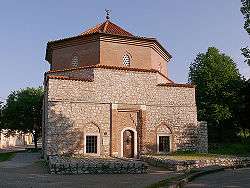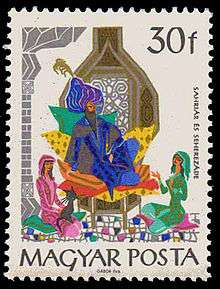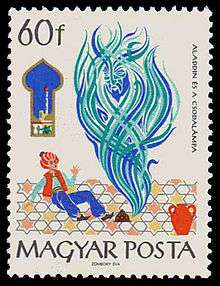Islam in Hungary

Islam in Hungary has a long history that dates back to at least the 10th century. The influence of Sunni Islam was especially pronounced in the 16th century during the Ottoman period in Hungary.
History
Early history
In the old form of the Hungarian language, Muslims were called Böszörmény, a term preserved as both a family name, and as that of the town Hajdúböszörmény.[1]
The first Islamic author to speak of this Muslim community was Yaqut al-Hamawi (575-626 AH/1179-1229 CE), he writes about a famous Hungarian student who studied in Aleppo, according to the student there were 30 Muslim villages in Hungary.[2] Yaqut writes in his famous geographical dictionary, "Mu'ajam al-Buldan",[3] about his meeting with a Hungarian Muslim youth in Syria who was studying Islam there and brought some details of the history and life of their people in Hungary. The Spaniard Muslim traveler Abu Hamid al Garnati wrote of two types of Muslims in Hungary, the first being the Böszörmény of the Carpathian Basin and Volga Bulgars (Khwarezmians).
In the 11th century, St. Ladislaus and later Coloman passed laws against the non-Christians (Synod of Szabolcs). These laws subdued Islam by coercing Muslims to eat pork, go to Church and intermarry and to forbid them from celebrating Friday. Some of Coloman's laws include:[4]
§ 46 If someone catches Ismaelites in fasting or eating or on keeping away from pork or in ritual washing or in other false practices these Ismaelites have to be sent to the king and whoever sued them shall receive a share from their properties.§ 47 We command all Ismaelite villages to build a church and finance it. After the church is built the half village should move and settle elsewhere in order to become similar to us in living together and also in Christ and in Church (i.e. become similar in faith).
§ 48 Ismaelites should not marry their daughters to their nation but only to our nation
§ 49 If an Ismaelite has guest, or he invites someone to his house to eat, he and his guests should all eat only pork.
László (Saint Ladislaus) passed the following law[5]
§ 9 on the merchants called Ismaelites, if becomes evident from them then after their baptism they return their old laws based on circumcision they should leave their homes but if they prove innocent they should stay
These laws imposed by the Catholic Church severely discriminated the small minority and eventually led to the disappearance of the community and its professions altogether.
Turkish rule of central Hungary

The Turks entered Hungary after the Battle of Mohács in 1526. From 1541 they started to control the central part directly and organized five vilayets: Buda, Kanije, Eğri, Várad (Oradea) and Temesvár.
In the 16th century, during the Ottoman rule, numerous Muslim personalities were born in Hungary. Among them, the most important were the Ottoman Grand Vizier, Kanijeli Siyavuş Pasha (from Nagykanizsa) who held the function three times between 1582 and 1593, and the famous Mevlevian dervish Pecsevi Árifi Ahmed Dede, a Turk native of Pécs. Most Islamic studies in Hungary were taught at the Hanafi madhhab or school of Sunni Islam.
Modern era
In the 19th century, after the collapse of the revolution of 1848-9, more than 6,000 emigrated Poles and Hungarians followed General Josef Bem into Turkish exile. Among them were such Hungarian officers such as Richard Guyon (Kurshid Pasha), György Kmety (Ismail Pasha) and Maximilian Stein (Ferhad Pasha). These personalities were afterwards raised to the post of General.
- Guyon is described in the Oxford Dictionary of National Biography as "the first Christian to obtain the rank of pasha and a Turkish military command without being obliged to change his religion", a sign of modernizing meritocracy under the 19th-century Ottomans.
The council of Újbuda has given permission for Muslim community in Hungary, to build the first Islamic centre in Budapest. The new Islamic centre will hold a library containing 50,000 volumes.[6][7]
In 2013 Hungarian Islamic Council requested for the Grand Mufti of Bosnia and Herzegovina Husein Kavazović to also become Grand Mufti of Hungary.[8]
Religious law
Hungary's new "Law on the Right to Freedom of Conscience and Religion, and on Churches, Religions and Religious Communities" was enacted 12 July 2011 and it recognizes only 14 religious groups. Islam is not included in this list and Muslims have to apply to get official recognition under the new law. Under the law, only 14 of 358 registered churches and religious associations will be granted legal recognition, while others will have to reapply for legal registration after two-thirds approval in parliament.[9]
On 27 February 2012, Hungary's parliament amended the country's controversial law on religious organizations to expand the list of officially recognized the Hungarian Islamic Council.[10]
Demographics
According to the 2011 Hungarian census, there were 5,579 Muslims in Hungary, made up 0.056% of the total population. Of these, 4,097 (73.4%) declared themselves as Hungarian, while 2,369 (42.5%) as Arab by ethnicity.[11] In Hungary people can declare more than one ethnicity (sum is greater than the whole),[12] so some people declared Hungarian and Arab together.
According to the Magyarországi Muszlimok Egyháza ("Hungarian Muslim's Church") there are c. 32,000 Muslims (0.3%) in Hungary.[13]
Gallery
 The daughters of the Grand Vizier: Scheherazade and Dunyazade, (from the One thousand and one nights).
The daughters of the Grand Vizier: Scheherazade and Dunyazade, (from the One thousand and one nights). Emerging Jinni, (from the One thousand and one nights).
Emerging Jinni, (from the One thousand and one nights).
See also
References
- ↑ Hajduboszormeny | HajduPorta
- ↑ (cf. "The Islamic Review", London, February 1950, 38th vol., No.2).
- ↑ (comp. 625/1228, vide also Wustenfeld's edition, Leipzig, 1866, 1st vol., p. 469)
- ↑ Coloman's Laws very free translation from Hungarian (original Latin).
- ↑ "Szent László törvényei". Retrieved 13 May 2015.
- ↑ "New Islamic Center in Budapest". 16 June 2009. Retrieved 13 May 2015.
- ↑ "Budapest district green-lights Islamic center". Retrieved 13 May 2015.
- ↑ http://www.radiosarajevo.ba/novost/122224/nocache
- ↑ "Churches Divided On Hungary's New Religion Law". Huffington Post. 19 July 2011.
- ↑ "In Hungary, amended religion law recognize Hungarian Islamic Council". Adventist.org. 28 February 2012.
- ↑ "Központi Statisztikai Hivatal". Retrieved 13 May 2015.
- ↑ Hungarian census 2011 - final data and methodology
- ↑ Administrator. "Túlmutatni önmagunkon". Retrieved 13 May 2015.

